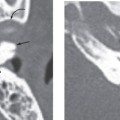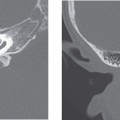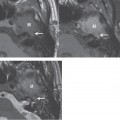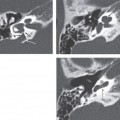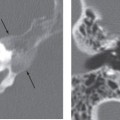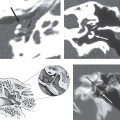CHAPTER 30 Adenoid Cystic Carcinoma
Epidemiology
Twenty-five percent of all salivary gland tumors arise from minor salivary glands, and 50% of minor salivary gland tumors are malignant. The smaller the minor salivary gland, the greater the risk that a tumor arising from that gland is malignant. The most common primary minor salivary gland malignancy is adenoid cystic carcinoma. As salivary gland tissue is rarely found in the middle ear (choristomas), it is possible that occasional primary minor salivary gland malignancies will occur in the middle ear. Less than a dozen such primary cases have been reported. Most adenoid cystic carcinomas of the middle ear region secondarily involve the middle ear as a result of cephalad perineural spread of a parotid gland adenoid cystic carcinoma along the seventh cranial nerve into the temporal bone.
Clinical Features
Primary middle ear adenoid cystic carcinoma is so rare that no specific clinical features can be described. As it is considered an aggressive tumor that can invade osseous structures (in this case, the temporal bone), it can be expected to present with pain, seventh nerve dysfunction, and conductive hearing loss depending on its extent. With invasion of the skull base or the intracranial compartment, additional cranial nerve and other symptoms may be present.
Perineural spread by adenoid cystic carcinoma along the facial nerve is often asymptomatic. However, it can present with progressive seventh nerve symptoms and possibly hearing loss depending on the extent of middle ear involvement. An otherwise asymptomatic parotid mass may be palpable.
Pathology
Primary temporal bone adenoid cystic carcinomas are considered a type of malignant ceruminous gland tumor (along with ceruminous adenocarcinomas) that usually arise in the external auditory canal as there is normally no salivary gland tissue in the middle ear. These are very rare tumors in the middle ear region. When they arise in the middle ear region, they are believed to arise from either ectopic salivary gland tissue (which has been identified in the middle ear region in pathologic studies) or multipotential middle ear mucosal cells (endodermal stem cells).
Treatment
Therapy involves surgery, radiation therapy, or chemotherapy depending on the extent of disease.
Imaging Findings
Stay updated, free articles. Join our Telegram channel

Full access? Get Clinical Tree


